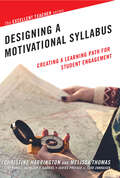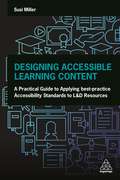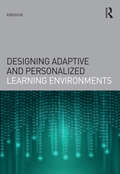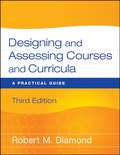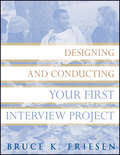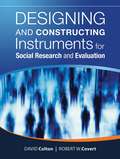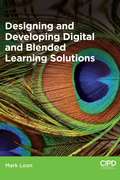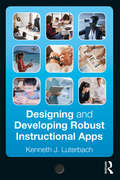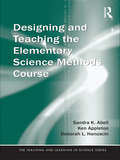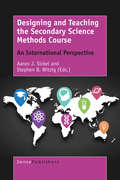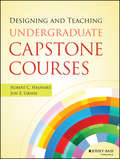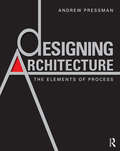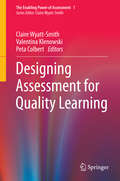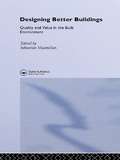- Table View
- List View
Designing a Motivational Syllabus: Creating a Learning Path for Student Engagement
by Christine Harrington Melissa ThomasA thoughtfully constructed syllabus can be transformative for your students’ learning, communicating the path they can take to succeed. This book demonstrates how, rather than being a mundane document to convey policies, you can construct your syllabus to be a motivating resource that conveys a clear sense of your course’s learning goals, how students can achieve those goals, and makes evident your teaching philosophy and why you have adopted the teaching strategies you will use, such as discussion or group activities. Developing or revising a syllabus also presents you with a perfect opportunity to review the learning possibilities for the semester. Well-designed, it can help you stay focused on achieving the learning outcomes, as well as determine if the class is on track and whether adjustments to the schedule are needed. The authors show how, by adopting a welcoming tone and clearly stating learning outcomes, your syllabus can engage students by explaining the relevance of your course to their studies, create an all-important positive first impression of you as an instructor, and guide students through the resources you will be using, the assignments ahead, as well as clear guidance on how they will be assessed. Referred to frequently as the course progresses, an effective syllabus will keep students engaged and on task.Christine Harrington and Melissa Thomas lead you through all the elements of a syllabus to help you identify how to present key messages and information about your course, think through the impressions you want to create, and, equally importantly, suggest how you can use layout and elements such as images and charts to make your syllabus visually appealing and easy to navigate.
Designing Accessible Learning Content: A Practical Guide to Applying best-practice Accessibility Standards to L&D Resources
by Susi MillerMaking learning and development (L&D) content inclusive and accessible for everyone is not only a good thing to do, it's the right thing to do. Designing Accessible Learning Content provides evidence-based advice on designing digital learning content that ensures all learners are included and are therefore able to perform to their full potential.This is a practical guide on accessibility for anyone involved in the design, creation, development or testing of online learning content. It provides detailed guidance on how to meet the Web Content Accessibility Guidelines making it essential reading for L&D professionals, instructional designers and course developers who need to comply with legal accessibility requirements. Using the author's 'eLearning Accessibility Framework', Designing Accessible Learning Content demystifies sometimes complex technical accessibility standards and provides an easy to follow contextual framework uniquely designed for learning content created using any authoring tool.This book also demonstrates how creating accessible learning content can improve usability and provide the best possible learning experience for everyone. In addition, it offers essential background information such as a focus on disability, an overview of assistive technology and an exploration of the case for digital accessibility. This guarantees that L&D professionals have the vital background knowledge they need to make sense of accessibility before they begin practically applying the principles. With online checklists, learner case studies, and industry perspectives, Designing Accessible Content is an essential handbook for all L&D professionals seeking to harness the benefits of accessibility in order to improve their learning content for everyone.
Designing Adaptive and Personalized Learning Environments (Interdisciplinary Approaches to Educational Technology)
by KinshukDesigning Adaptive and Personalized Learning Environments provides a theoretically-based yet practical guide to systematic design processes for learning environments that provide automatic customization of learning and instruction. The book consists of four main sections: In "Introduction and Overview," the concepts of adaptivity and personalization are introduced and explored in detail. In "Theoretical Perspectives with Example Applications," various theoretical concepts underlying adaptive and personalized learning are discussed, including cognitive profiling, content-based adaptivity, exploration-based adaptivity, and mobile and ubiquitous settings. In "Practical Perspectives with Example Applications," the implementation process for adaptive and personalized learning environments is described, followed by application in various contexts. In "Validation and Future Trends," various evaluation techniques for validating the efficiency and efficacy of adaptive and personalized learning systems are discussed. This final section concludes with a discussion of emerging trends in adaptive and personalized learning research. Based on cutting-edge research, Designing Adaptive and Personalized Learning Environments is appropriate as a primary textbook for both undergraduate and graduate courses focused on the design of learning systems, and as a secondary textbook for a variety of courses in programs such as educational technology, instructional design, learning sciences, digital literacy, computer based systems, and STEM content fields.
Designing Adaptive and Personalized Learning Environments (Interdisciplinary Approaches to Educational Technology)
by KinshukDesigning Adaptive and Personalized Learning Environments provides a theoretically-based yet practical guide to systematic design processes for learning environments that provide automatic customization of learning and instruction. The book consists of four main sections: In "Introduction and Overview," the concepts of adaptivity and personalization are introduced and explored in detail. In "Theoretical Perspectives with Example Applications," various theoretical concepts underlying adaptive and personalized learning are discussed, including cognitive profiling, content-based adaptivity, exploration-based adaptivity, and mobile and ubiquitous settings. In "Practical Perspectives with Example Applications," the implementation process for adaptive and personalized learning environments is described, followed by application in various contexts. In "Validation and Future Trends," various evaluation techniques for validating the efficiency and efficacy of adaptive and personalized learning systems are discussed. This final section concludes with a discussion of emerging trends in adaptive and personalized learning research. Based on cutting-edge research, Designing Adaptive and Personalized Learning Environments is appropriate as a primary textbook for both undergraduate and graduate courses focused on the design of learning systems, and as a secondary textbook for a variety of courses in programs such as educational technology, instructional design, learning sciences, digital literacy, computer based systems, and STEM content fields.
Designing and Assessing Courses and Curricula: A Practical Guide
by Robert M. DiamondDesigning and Assessing Courses and Curricula reflects the most current knowledge and practice in course and curriculum design and connects this knowledge with the critical task of assessing learning outcomes at both course and curricular levels. This thoroughly revised and expanded third edition of the best-selling book positions course design as a tool for educational change and contains a wealth of new material including new chapters, case examples, and resources.
Designing and Assessing Courses and Curricula: A Practical Guide
by Robert M. DiamondDesigning and Assessing Courses and Curricula reflects the most current knowledge and practice in course and curriculum design and connects this knowledge with the critical task of assessing learning outcomes at both course and curricular levels. This thoroughly revised and expanded third edition of the best-selling book positions course design as a tool for educational change and contains a wealth of new material including new chapters, case examples, and resources.
Designing and Conducting Your First Interview Project (Research Methods for the Social Sciences #17)
by Bruce K. FriesenDesigning and Conducting Your First Interview Project Using a clear, easily followed approach, Designing and Conducting Your First Interview Project helps anyone new to the process develop the skills to conduct the most essential part of social research data collection: the interview. The book also shows how to organize, analyze, and interpret the data. This workbook provides a step-by-step template for a collaborative class experience in social science. Organized according to the steps of the deductive scientific method, it includes essential activities to take place during class after the appropriate chapter has been read. The book begins with the process of choosing a topic and proceeds through hypothesis development, interview data collection, data entry using SPSS, and elementary data analysis. The final chapter includes the formal assignment and instructions to students on how to write about their experiences in a way that will produce an excellent final paper. By selecting the hypothesis, gathering the data, and analyzing the results, students will gain an appreciation for the strengths and potential weaknesses of "knowing" things through doing quantitative social science.
Designing and Conducting Your First Interview Project (Research Methods for the Social Sciences #17)
by Bruce K. FriesenDesigning and Conducting Your First Interview Project Using a clear, easily followed approach, Designing and Conducting Your First Interview Project helps anyone new to the process develop the skills to conduct the most essential part of social research data collection: the interview. The book also shows how to organize, analyze, and interpret the data. This workbook provides a step-by-step template for a collaborative class experience in social science. Organized according to the steps of the deductive scientific method, it includes essential activities to take place during class after the appropriate chapter has been read. The book begins with the process of choosing a topic and proceeds through hypothesis development, interview data collection, data entry using SPSS, and elementary data analysis. The final chapter includes the formal assignment and instructions to students on how to write about their experiences in a way that will produce an excellent final paper. By selecting the hypothesis, gathering the data, and analyzing the results, students will gain an appreciation for the strengths and potential weaknesses of "knowing" things through doing quantitative social science.
Designing and Constructing Instruments for Social Research and Evaluation (Research Methods for the Social Sciences)
by David Colton Robert W. CovertWritten in easy-to-understand language, this important text provides a systematic and commonsense approach to developing instruments for data collection and analysis. This book can be used by both those who are developing instruments for the first time and those who want to hone their skills, including students, agency personnel, program managers, and researchers. This book provides a thorough presentation of instrument construction, from conception to development and pre-testing of items, formatting the instrument, administration, and, finally, data management and presentation of the findings. Throughout the book, the authors emphasize how to create an instrument that will produce trustworthy and accurate data. To that end they have included guidelines for reviewing and revising the questionnaire to enhance validity and reliability. They also show how to work effectively with stakeholders such as instruments designers, decision-makers, agency personnel, clients, and raters or respondents.
Designing and Constructing Instruments for Social Research and Evaluation (Research Methods for the Social Sciences)
by David Colton Robert W. CovertWritten in easy-to-understand language, this important text provides a systematic and commonsense approach to developing instruments for data collection and analysis. This book can be used by both those who are developing instruments for the first time and those who want to hone their skills, including students, agency personnel, program managers, and researchers. This book provides a thorough presentation of instrument construction, from conception to development and pre-testing of items, formatting the instrument, administration, and, finally, data management and presentation of the findings. Throughout the book, the authors emphasize how to create an instrument that will produce trustworthy and accurate data. To that end they have included guidelines for reviewing and revising the questionnaire to enhance validity and reliability. They also show how to work effectively with stakeholders such as instruments designers, decision-makers, agency personnel, clients, and raters or respondents.
Designing and Developing Digital and Blended Learning Solutions
by Mark LoonDesigning and Developing Digital and Blended Learning Solutions is essential reading for anyone studying the Level 5 CIPD L&D module of the same name as well as all learning and development professionals looking to understand the growing role of technology in L&D. Covering both current and emerging learning technologies, this book will help readers assess which technologies are right for their needs. It also covers how to design blended learning solutions, how to develop digital learning content as well as how to evaluate the effectiveness of this digital content. Most importantly, Designing and Developing Digital and Blended Learning Solutions provides guidance on how to implement digital and blended learning solutions including identifying the appropriate platforms and the roles, tools and processes needed to support effective implementation. Full of practical examples and advice, this is an invaluable guide for students and practitioners alike.
Designing and Developing Digital and Blended Learning Solutions
by Mark LoonDesigning and Developing Digital and Blended Learning Solutions is essential reading for anyone studying the Level 5 CIPD L&D module of the same name as well as all learning and development professionals looking to understand the growing role of technology in L&D. Covering both current and emerging learning technologies, this book will help readers assess which technologies are right for their needs. It also covers how to design blended learning solutions, how to develop digital learning content as well as how to evaluate the effectiveness of this digital content. Most importantly, Designing and Developing Digital and Blended Learning Solutions provides guidance on how to implement digital and blended learning solutions including identifying the appropriate platforms and the roles, tools and processes needed to support effective implementation. Full of practical examples and advice, this is an invaluable guide for students and practitioners alike.
Designing and Developing Robust Instructional Apps
by Kenneth J. LuterbachDesigning and Developing Robust Instructional Apps advances the state of instructional app development using three learning paradigms for building knowledge foundations, problem-solving, and experimentation. Drawing on research and development lessons gleaned?from noted educational technologists, time-tested systematic instructional design processes, and results from user experience design, the book considers the planning and specification of instructional apps that blend media (text, images, sound, and moving pictures) and instructional method. Further, for readers with little to no programming experience, introductory treatments of JavaScript and Python, along with data fundamentals and machine learning techniques, offer a guided journey that produces robust instructional apps and?concludes with next steps for advancing the state of instructional app development.
Designing and Developing Robust Instructional Apps
by Kenneth J. LuterbachDesigning and Developing Robust Instructional Apps advances the state of instructional app development using three learning paradigms for building knowledge foundations, problem-solving, and experimentation. Drawing on research and development lessons gleaned?from noted educational technologists, time-tested systematic instructional design processes, and results from user experience design, the book considers the planning and specification of instructional apps that blend media (text, images, sound, and moving pictures) and instructional method. Further, for readers with little to no programming experience, introductory treatments of JavaScript and Python, along with data fundamentals and machine learning techniques, offer a guided journey that produces robust instructional apps and?concludes with next steps for advancing the state of instructional app development.
Designing and Implementing a Successful Undergraduate Research, Scholarship and Creative Activity Program (Routledge Undergraduate Research Series)
by John Banks Holly Unruh Heather Haeger Winny DongDesigning and Implementing a Successful Undergraduate Research, Scholarship and Creative Activity Program is designed as a resource for faculty, administrators, and university leaders interested in developing new, or expanding existing, undergraduate research programs. The book provides a practical handbook addressing the many "how to" questions associated with running a successful undergraduate research enterprise – ranging from how to organize an undergraduate research office, to how to find funding, foster cross-campus relationships, and develop learning outcomes for students in order to maximize the benefits of the research experience. It also addresses best practices in mentoring, how faculty mentorship fits within the discussion of tenure and promotion, and the basics of assessment, for both funder reporting and program improvement.Containing a series of vignettes offering specific advice from program directors, faculty mentors, and university administrators from a diverse array of universities and colleges, this book showcases their hands-on tips, advice, and lessons learned. Addressing key issues through real-world experience, the authors show how to build effective cross-disciplinary undergraduate research programs with positive impacts for students and faculty.
Designing and Implementing a Successful Undergraduate Research, Scholarship and Creative Activity Program (Routledge Undergraduate Research Series)
by John Banks Holly Unruh Heather Haeger Winny DongDesigning and Implementing a Successful Undergraduate Research, Scholarship and Creative Activity Program is designed as a resource for faculty, administrators, and university leaders interested in developing new, or expanding existing, undergraduate research programs. The book provides a practical handbook addressing the many "how to" questions associated with running a successful undergraduate research enterprise – ranging from how to organize an undergraduate research office, to how to find funding, foster cross-campus relationships, and develop learning outcomes for students in order to maximize the benefits of the research experience. It also addresses best practices in mentoring, how faculty mentorship fits within the discussion of tenure and promotion, and the basics of assessment, for both funder reporting and program improvement.Containing a series of vignettes offering specific advice from program directors, faculty mentors, and university administrators from a diverse array of universities and colleges, this book showcases their hands-on tips, advice, and lessons learned. Addressing key issues through real-world experience, the authors show how to build effective cross-disciplinary undergraduate research programs with positive impacts for students and faculty.
Designing and Teaching the Elementary Science Methods Course (Teaching and Learning in Science Series)
by Sandra K. Abell Ken Appleton Deborah L. HanuscinWhat do aspiring and practicing elementary science teacher education faculty need to know as they plan and carry out instruction for future elementary science teachers? This scholarly and practical guide for science teacher educators outlines the theory, principles, and strategies needed, and provides classroom examples anchored to those principles. The theoretical and empirical foundations are supported by scholarship in the field, and the practical examples are derived from activities, lessons, and units field-tested in the authors’ elementary science methods courses. Designing and Teaching the Elementary Science Methods Course is grounded in the theoretical framework of pedagogical content knowledge (PCK), which describes how teachers transform subject matter knowledge into viable instruction in their discipline. Chapters on science methods students as learners, the science methods course curriculum, instructional strategies, methods course assessment, and the field experience help readers develop their PCK for teaching prospective elementary science teachers. "Activities that Work" and "Tools for Teaching the Methods Course" provide useful examples for putting this knowledge into action in the elementary science methods course.
Designing and Teaching the Elementary Science Methods Course (Teaching and Learning in Science Series)
by Sandra K. Abell Ken Appleton Deborah L. HanuscinWhat do aspiring and practicing elementary science teacher education faculty need to know as they plan and carry out instruction for future elementary science teachers? This scholarly and practical guide for science teacher educators outlines the theory, principles, and strategies needed, and provides classroom examples anchored to those principles. The theoretical and empirical foundations are supported by scholarship in the field, and the practical examples are derived from activities, lessons, and units field-tested in the authors’ elementary science methods courses. Designing and Teaching the Elementary Science Methods Course is grounded in the theoretical framework of pedagogical content knowledge (PCK), which describes how teachers transform subject matter knowledge into viable instruction in their discipline. Chapters on science methods students as learners, the science methods course curriculum, instructional strategies, methods course assessment, and the field experience help readers develop their PCK for teaching prospective elementary science teachers. "Activities that Work" and "Tools for Teaching the Methods Course" provide useful examples for putting this knowledge into action in the elementary science methods course.
Designing and Teaching the Secondary Science Methods Course: An International Perspective
by Aaron J. Sickel Stephen B. WitzigThe improvement of science education is a common goal worldwide. Countries not only seek to increase the number of individuals pursuing careers in science, but to improve scientific literacy among the general population. As the teacher is one of the greatest influences on student learning, a focus on the preparation of science teachers is essential in achieving these outcomes. A critical component of science teacher education is the methods course, where pedagogy and content coalesce. It is here that future science teachers begin to focus simultaneously on the knowledge, dispositions and skills for teaching secondary science in meaningful and effective ways. This book provides a comparison of secondary science methods courses from teacher education programs all over the world. Each chapter provides detailed descriptions of the national context, course design, teaching strategies, and assessments used within a particular science methods course, and is written by teacher educators who actively research science teacher education. The final chapter provides a synthesis of common themes and unique features across contexts, and offers directions for future research on science methods courses. This book offers a unique combination of ‘behind the scenes’ thinking for secondary science methods course designs along with practical teaching and assessment strategies, and will be a useful resource for teacher educators in a variety of international contexts.
Designing and Teaching Undergraduate Capstone Courses
by Robert C. Hauhart Jon E. GraheEnrich your students and the institution with a high-impact practice Designing and Teaching Undergraduate Capstone Courses is a practical, research-backed guide to creating a course that is valuable for both the student and the school. The book covers the design, administration, and teaching of capstone courses throughout the undergraduate curriculum, guiding departments seeking to add a capstone course, and allowing those who have one to compare it to others in the discipline. The ideas presented in the book are supported by regional and national surveys that help the reader understand what's common, what's exceptional, what works, and what doesn't within capstone courses. The authors also provide additional information specific to different departments across the curriculum, including STEM, social sciences, humanities, fine arts, education, and professional programs. Identified as a high-impact practice by the National Survey of Student Engagement (NSSE) and the Association of American Colleges and Universities' LEAP initiative, capstone courses culminate a student's final college years in a project that integrates and applies what they've learned. The project takes the form of a research paper, a performance, a portfolio, or an exhibit, and is intended to showcase the student's very best work as a graduating senior. This book is a guide to creating for your school or department a capstone course that ties together undergraduate learning in a way that enriches the student and adds value to the college experience. Understand what makes capstone courses valuable for graduating students Discover the factors that make a capstone course effective, and compare existing programs, both within academic disciplines and across institutions Learn administrative and pedagogical techniques that increase the course's success Examine discipline-specific considerations for design, administration, and instruction Capstones are generally offered in departmental programs, but are becoming increasingly common in general education as well. Faculty and administrators looking to add a capstone course or revive an existing one need to understand what constitutes an effective program. Designing and Teaching Undergraduate Capstone Courses provides an easily digested summary of existing research, and offers expert guidance on making your capstone course successful.
Designing and Teaching Undergraduate Capstone Courses
by Robert C. Hauhart Jon E. GraheEnrich your students and the institution with a high-impact practice Designing and Teaching Undergraduate Capstone Courses is a practical, research-backed guide to creating a course that is valuable for both the student and the school. The book covers the design, administration, and teaching of capstone courses throughout the undergraduate curriculum, guiding departments seeking to add a capstone course, and allowing those who have one to compare it to others in the discipline. The ideas presented in the book are supported by regional and national surveys that help the reader understand what's common, what's exceptional, what works, and what doesn't within capstone courses. The authors also provide additional information specific to different departments across the curriculum, including STEM, social sciences, humanities, fine arts, education, and professional programs. Identified as a high-impact practice by the National Survey of Student Engagement (NSSE) and the Association of American Colleges and Universities' LEAP initiative, capstone courses culminate a student's final college years in a project that integrates and applies what they've learned. The project takes the form of a research paper, a performance, a portfolio, or an exhibit, and is intended to showcase the student's very best work as a graduating senior. This book is a guide to creating for your school or department a capstone course that ties together undergraduate learning in a way that enriches the student and adds value to the college experience. Understand what makes capstone courses valuable for graduating students Discover the factors that make a capstone course effective, and compare existing programs, both within academic disciplines and across institutions Learn administrative and pedagogical techniques that increase the course's success Examine discipline-specific considerations for design, administration, and instruction Capstones are generally offered in departmental programs, but are becoming increasingly common in general education as well. Faculty and administrators looking to add a capstone course or revive an existing one need to understand what constitutes an effective program. Designing and Teaching Undergraduate Capstone Courses provides an easily digested summary of existing research, and offers expert guidance on making your capstone course successful.
Designing Architecture: The Elements of Process
by Andrew PressmanDesigning Architecture is an indispensable tool to assist both students and young architects in formulating an idea, transforming it into a building, and making effective design decisions. This book promotes integrative and critical thinking in the preliminary design of buildings to inspire creativity, innovation, and design excellence. This compendium of individual wisdom and collective experience offers explicit guidance to students and young professionals on how to approach, analyze, and execute specific tasks; develop and refine a process to facilitate the best possible design projects; and create meaningful architectural form. Here the design process – from orchestrating client participation to finalizing schematic design – is explored and illuminated. The following material is presented to make the book a useful didactic tool for professional development: explicit strategies for doing design rather than simply reviewing principles and precedents creative ideas in approaching and framing problems in design terms specific methods to translate ideas to culturally significant, socially responsive, and environmentally sensitive buildings techniques to integrate all levels of cognition from analysis to epiphany counsel on developing a personalized process for engaging design projects case studies augment the text and chronicle fascinating applications of the design process. The essence of this book lies in an integrated and holistic approach to each unique project as well as fostering curiosity and exploration – a departure from algorithms, easy generalities, or a formula for design. Designing Architecture will inspire readers to elevate the quality of preliminary designs and unravel some of the mystery of creating the most beautiful, responsive, and responsible architectural design possible.
Designing Architecture: The Elements of Process
by Andrew PressmanDesigning Architecture is an indispensable tool to assist both students and young architects in formulating an idea, transforming it into a building, and making effective design decisions. This book promotes integrative and critical thinking in the preliminary design of buildings to inspire creativity, innovation, and design excellence. This compendium of individual wisdom and collective experience offers explicit guidance to students and young professionals on how to approach, analyze, and execute specific tasks; develop and refine a process to facilitate the best possible design projects; and create meaningful architectural form. Here the design process – from orchestrating client participation to finalizing schematic design – is explored and illuminated. The following material is presented to make the book a useful didactic tool for professional development: explicit strategies for doing design rather than simply reviewing principles and precedents creative ideas in approaching and framing problems in design terms specific methods to translate ideas to culturally significant, socially responsive, and environmentally sensitive buildings techniques to integrate all levels of cognition from analysis to epiphany counsel on developing a personalized process for engaging design projects case studies augment the text and chronicle fascinating applications of the design process. The essence of this book lies in an integrated and holistic approach to each unique project as well as fostering curiosity and exploration – a departure from algorithms, easy generalities, or a formula for design. Designing Architecture will inspire readers to elevate the quality of preliminary designs and unravel some of the mystery of creating the most beautiful, responsive, and responsible architectural design possible.
Designing Assessment for Quality Learning (The Enabling Power of Assessment #1)
by Claire Wyatt-Smith Valentina Klenowski Peta ColbertThis book brings together internationally recognised scholars with an interest in how to use the power of assessment to improve student learning and to engage with accountability priorities at both national and global levels. It includes distinguished writers who have worked together for some two decades to shift the assessment paradigm from a dominant focus on assessment as measurement towards assessment as central to efforts to improve learning. These writers have worked with the teaching profession and, in so doing, have researched and generated key insights into different ways of understanding assessment and its relationship to learning.The volume contributes to the theorising of assessment in contexts characterised by heightened accountability requirements and constant change. The book’s structure and content reflect already significant and growing international interest in assessment as contextualised practice, as well as theories of learning and teaching that underpin and drive particular assessment approaches. Learning theories and practices, assessment literacies, teachers’ responsibilities in assessment, the role of leadership, and assessment futures are the organisers within the book’s structure and content.The contributors to this book have in common the view that quality assessment, and quality learning and teaching are integrally related. Another shared view is that the alignment of assessment with curriculum, teaching and learning is linchpin to efforts to improve both learning opportunities and outcomes for all. Essentially, the book presents new perspectives on the enabling power of assessment. In so doing, the writers recognise that validity and reliability - the traditional canons of assessment – remain foundational and therefore necessary. However, they are not of themselves sufficient for quality education. The book argues that assessment needs to be radically reconsidered in the context of unprecedented societal change. Increasingly, communities are segregating more by wealth, with clear signs of social, political, economic and environmental instability. These changes raise important issues relating to ethics and equity, taken to be core dimensions in enabling the power of assessment to contribute to quality learning for all. This book offers readers new knowledge about how assessment can be used to re/engage learners across all phases of education.
Designing Better Building: Quality And Value In The Built Environment
by Sebastian MacmillanDesign is widely recognised as the key to improving the quality of the built environment. This well-illustrated book comprises 15 chapters written by leading practitioners, clients, academics and other experts, and presents the latest thinking on what design quality is and how to achieve it. For design practitioners and their clients alike, the book provides evidence to justify greater focus on, and investment in, design. It summarises the benefits that arise from good design - such as, civic pride in the urban environment, the stimulation of urban regeneration, corporate identity, occupant productivity and health in offices, improved learning outcomes in schools, better patient recovery rates in hospitals, as well as reduced environmental impact. And it illustrates these benefits through case study examples. Eight chapters focus on case studies of exemplary buildings in particular sectors - offices, schools, housing, and hospitals - and explain why and how they came to be designed, and the design qualities they exhibit.
